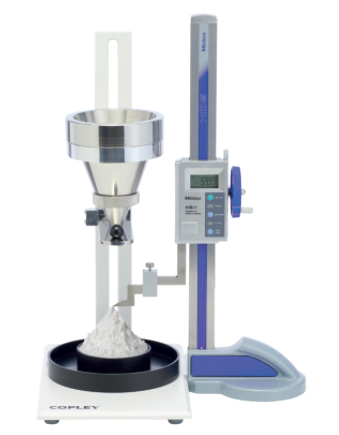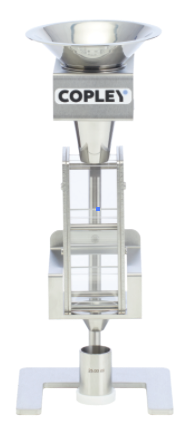Quality Assurance-Physical
Powder Testing: Flowability & Densities (Bulk, Tapped)
A pharmaceutical powder is a dry, bulk solid composed of many very fine particles normally classified dependent on particle size between coarse and very fine (see USP Chapter <811> Powder Fineness).
Whilst powders themselves are not widely employed as a dosage form in their own right, they are often used in the preparation of other forms such as tablets, capsules and inhaled products and are frequently added to other ingredients to make semisolids such as creams, ointments and pastes.
It is this widespread use of powders in the pharmaceutical industry that has led to a proliferation of test methods for measuring powder flow and density.
USP <1174> and Ph. Eur. 2.9.36 list four well-defined methods for powder testing proposed to bring some degree of test methodology standardisation:
- Flow through an orifice
- Angle of repose
- Shear cell
- Compressibility index and Hausner ratio
Powder flow depends on several factors, some of which relate to the powder material and some to the actual manufacturing processes, its ability, for example, to flow from a container (hopper, funnel, cylinder, etc.) or its compressibility in forming a tablet. The Pharmacopoeias recommend three methods for testing powder flow:
- Flow Through an Orifice

Measuring the ability and the time taken for a powder to flow through an orifice of known size is a useful method of quantifying powders. As the name suggests, this technique is only applicable to free-flowing powders, not cohesive materials. Methods vary but can be classified on the basis of three basic experimental variables:
a) Type of container employed (hopper, funnel, cylinder, etc.)
b) Size and shape of the orifice employed
c) Method of measuring powder flow rate
- Angle of Repose

The Angle of Repose is the angle (relative to the horizontal base) of the conical pile produced when a granular material is poured onto a horizontal surface. It is related to the density, surface area and coefficient of friction of the material concerned and indicative of flow in accordance with the values shown in the table overleaf.
- Shear Cell

Measures the force required to shear a circular disk through a prepared sample of bulk material.
It comprises 2 stages:
a) Sample consolidation (bulk density measurement)
b) Failure inducement (shear strength)
Shear Cell methodology widely used in the pharmaceutical industry to determine the flow properties of fine-grained powders and bulk solids and how they will behave in bins, hoppers, feeders and other handling equipment. The ability of a powder to flow through such devices is dependent on the bulk density of the material concerned and its shear strength.
Bulk density of a powder is expressed in terms of grams per mL by dividing the weight of a given “untapped” powder sample by its volume. It is important to ensure that no settlement occurs during preparation such that the density of the powder concerned is “as poured” and therefore includes the contribution made by the volume of the interparticle void.
Tapped Density, on the other hand, is the density attained after “tamping down”. This is normally measured using an instrument that lifts and the drops a measuring cylinder or similar vessel containing the powder through a fixed distance. The Tapped Density in grams per mL can now be calculated by dividing the sample weight by the final tapped volume.
Measures of the ability of the powder to flow and its compressibility can now be given in the form of the Hausner ratio (Tapped Density/Bulk Density) and the Compressibility Index (Tapped Density – Bulk Density/Tapped Density) x 100).
- Powders: Bulk Density Tester

The Bulk Density Tester (Scott Volumeter) is described in Ph. Eur. and USP and is designed for measuring the bulk density of fine powders and similar products.
The bulk density of powders can be extremely difficult to measure since the slightest disturbance may result in a change in the results. This is the result of the relationship between the particles that constitute the powder bulk. This same relationship affects the ability of the powder to flow. The Scott Volumeter obviates this problem.
Scott Volumeter: Key Features
- Stainless steel top funnel with an integral 18 or 10 – mesh stainless steel screen
- Stainless steel bottom funnel
- A baffle box with four glass plates
- A cylindrical receiving cup having a capacity of 25 +/- 0.05 mL
- Powders: Tapped Density Tester

A high reliability solution for routine measurement of the tapped density of powders, granules and similar products, the Copley JVi testers are the only single tapped density systems on the market that offer all three methods specified in Eur. Ph. and USP.
Available with either one (JV 100i) or two (JV 200i) test stations, the JVi tapped density series provides detailed reports, including Hausner ratio calculations for a wide range of industrial standards.
JVi Series: Key Features
- Various cylinder sizes available
- Easily removable platforms for changing between methods
- Intuitive touchscreen control with icon-based menu structure simplifies operation and clearly displays test parameters throughout run
- Small footprint saves precious benchtop space
- Robust metal case with advanced corrosion protective coating

